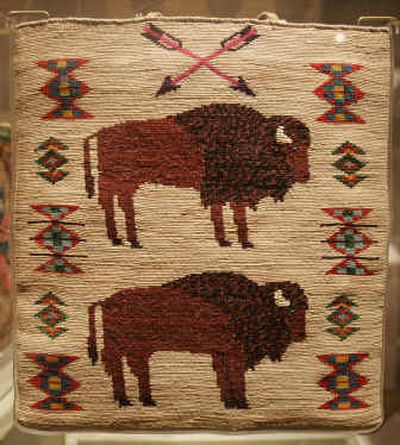Columbia River tribes’ art on exhibition in Portland

PORTLAND – Long before Lewis and Clark arrived, a unique art style developed along the largest waterway in the Northwest.
Tribes living along the Columbia River etched skeletal human forms with rounded faces into bone hairpins. They cut geometric and animal designs into antler adzes and bighorn-sheep-horn bowls. And they carved representations of human ribs into cedar planks, which graced the interiors of their homes.
Their art is the subject of the Portland Art Museum’s newest exhibit, “People of the River: Native Arts of the Oregon Territory.”
The show features artwork and decorated tools from dozens of Columbia River tribes – like a tightly woven cylindrical cedar root basket, a block of gray basalt painstakingly pounded into a bird-shaped bowl and a fine woven cornhusk bag.
When anthropological and art museums started opening in the 1800s, said Bill Mercer, the museum’s curator of Native American art, artifacts and artwork of the Columbia River weren’t easy to get to, so the region “sort of got lumped together,” with native arts from the Northwest Coast.
Artistic works by people of the Northwest Coast, closer to Alaska, were “big sexy pieces,” like masks and totem poles, Mercer said. Columbia River art is very different and distinct from that, and any other region.
“There was an absolutely indigenous artistic style that was directly from the Columbia River. It emerged here, developed here, and wasn’t derivative of any other area of North America,” Mercer said.
Kenneth M. Ames, professor of anthropology at Portland State University, said the artifacts of “People of the River” are unique and “give us a window into a whole range of objects that at one time existed but are virtually lost” due to the damming of the Columbia River, which began in the 1930s.
Dams submerged historic living sites from the Snake River to the Oregon Coast. Items in “People of the River” represent objects saved before that happened.
More than 200 pieces of art for the show came from museums and private sources all over the country. Viewers will find descriptions with each piece but no mention of the tribe from which it hails. That’s because the dozens of tribes and smaller cultural groups that lived along the Columbia River lived close to one another and often shared cultural knowledge, familial ties and traditions, said Mercer. It was impossible, he said, to draw distinct differences between groups and tribes.
George Horse Capture, senior counselor to the director of the National Museum of the American Indian, said it was a miracle that any of the tribal bands along the Columbia survived at all.
“The tribes of the Columbia have a very fascinating story,” said Horse Capture. “Their lives were shaped by the bounty from the ocean and the bounty from the land, the geographic area, and the lava beds.”
” ‘People of the River’ will begin to tell their story,” he said. But for those who listen, “they have many more stories to tell.”